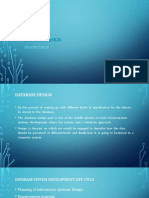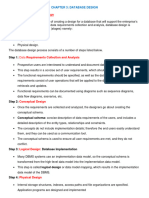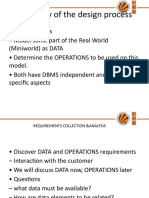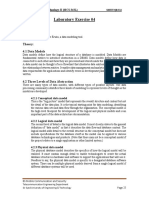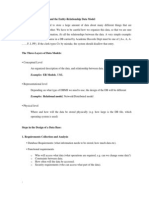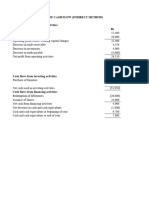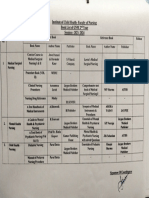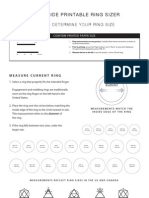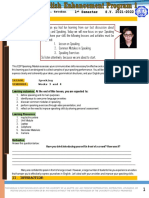Chapter Three
Database Design
Database design is the process of coming up with different kinds of specification for the data to be
stored in the database. The database design part is one of the middle phases we have in information
systems development where the system uses a database approach. Design is the part on which we
would be engaged to describe how the data should be perceived at different levels and finally how
it is going to be stored in a computer system.
Information System with Database application consists of several tasks which include:
Planning of Information systems Design
Requirements Analysis,
Design (Conceptual, Logical and Physical Design)
Tuning
Implementation
Operation and Support
From these different phases, the prime interest of a database system will be the Design part which
is again sub divided into other three sub-phases. These sub-phases are:
1. Conceptual Design
2. Logical Design, and
3. Physical Design
In general, one has to go back and forth between these tasks to refine a database design,
and decisions in one task can influence the choices in another task.
In developing a good design, one should answer such questions as:
What are the relevant Entities for the Organization
What are the important features of each Entity
What are the important Relationships
What are the important queries from the user
What are the other requirements of the Organization and the Users
The Three levels of Database Design
1
� Conceptual Design
Logical Design
Physical Design
Conceptual Database Design
Conceptual design is the process of constructing a model of the information used in an
enterprise, independent of any physical considerations.
It is the source of information for the logical design phase.
Mostly uses a Conceptual Data Model to describe the data at this level. Best
example of conceptual data model for relational database is Entity Relationship Model.
After the completion of Conceptual Design one has to go for refinement of the
schema, which is verification of Entities, Attributes, and Relationships
Logical Database Design
Logical design is the process of constructing a model of the information used in an
enterprise based on a specific data model (e.g. relational, hierarchical or network or object),
but independent of a particular DBMS and other physical considerations.
Normalization process
Collection of Rules to be maintained
Discover new entities in the process
Revise attributes based on the rules and the discovered Entities
Physical Database Design
Physical design is the process of producing a description of the implementation of the
database on secondary storage. -- defines specific storage or access methods used by
database
Describes the storage structures and access methods used to achieve efficient access
to the data.
Tailored to a specific DBMS system -- Characteristics are function of DBMS and
operating systems
Includes estimate of storage space
2
� Conceptual Database Design
Conceptual design revolves around discovering and analyzing organizational and user data
requirements
The important function (activities) of conceptual design in the database is:
Identify relevant entities and relationships in the enterprise.
Identify information about these entities and relationships should we store in the database.
Identify the basic integrity constraints that hold? Constraints on each data with respect to
update, retrieval and store.
Finally represent this information by using conceptual data model. One of the best
examples of conceptual data model is ER model. ER model represent the data of
organization pictorially in ER diagrams. Besides we used this model when we develop
relational database. However if we develop object oriented database, we used object model.
Object model is another example of conceptual data model. Therefore conceptual data
model is selected based on type of DBMS.
The Entity Relationship (E-R) Model
Entity-Relationship modeling is used to represent conceptual view of the database
The main components of ER Modeling are:
o Entities
Corresponds to entire table, not row
Represented by Rectangle
o Attributes
Represents the property used to describe an entity or a relationship
Represented by Oval
o Relationships
Represents the association that exist between entities
Represented by Diamond
o Constraints
Represent the constraint in the data
Developing an E-R Model
Designing conceptual model for the database is not a one linear process but an iterative activity
where the design is refined again and again.
To identify the entities, attributes, relationships, and constraints on the data, there are different set
of methods used during the analysis phase. These include information gathered by…
Interviewing end users individually and in a group
Questionnaire survey
3
� Direct observation
Examining different documents
The basic E-R model is graphically depicted and presented for review.
The process is repeated until the end users and designers agree that the E-R diagram is a fair
representation of the organization’s activities and functions.
Checking for Redundant Relationships in the ER Diagram. Relationships between entities indicate
access from one entity to another - it is therefore possible to access one entity occurrence from
another entity occurrence even if there are other entities and relationships that separate them - this
is often referred to as Navigation' of the ER diagram
The last phase in ER modeling is validating an ER Model against requirement of the user.
Graphical Representations in ER Diagramming
Entity is represented by a RECTANGLE containing the name of the entity.
Strong Entity Weak Entity
Connected entities are
called relationship participants
Attributes are represented by OVALS and are connected
to the entity by a line.
Ov
Ovals Ovals Ovals Ov
Multi-valued Composite Ov
Attribute Attribute Attribute
A derived attribute is indicated by a DOTTED LINE. (……..)
Oval
s
PRIMARY KEYS are underlined.
Ke
y
Relationships are represented by DIAMOND shaped symbols
Weak Relationship is a relationship between Weak and Strong Entities
Strong Relationship is a relationship between two strong Entities
4
� Diamon Diamon
d d
Strong Relationship Weak Relationship
Example 1: Build an ER Diagram for the following information:
A student record management system will have the following two basic data object
categories with their own features or properties: Students will have an Id, Name, Dept,
Age, GPA and Course will have an Id, Name, Credit Hours
Whenever a student enroll in a course in a specific Academic Year and Semester,
the Student will have a grade for the course
Name Dept DoB Id Name Credit
Id Gpa
Students Course
s
Age
Enrolled_In Semester
Academic
Year
Grade
Example 2: Build an ER Diagram for the following information:
A Personnel record management system will have the following two basic data object
categories with their own features or properties: Employee will have an Id, Name, DoB,
Age, Tel and Department will have an Id, Name, Location
Whenever an Employee is assigned in one Department, the duration of his stay in
the respective department should be registered.
5
� Structural Constraints on Relationship
1. Constraints on Relationship / Multiplicity/ Cardinality Constraints
Multiplicity constraint is the number or range of possible occurrence of tuple of a one entity
related with the tuple of another entity through a particular relationship.
Mostly used to insure appropriate enterprise constraints.
One-to-one relationship:
A customer is associated with at most one loan via the relationship borrower
A loan is associated with at most one customer via borrower
E.g.: Relationship Manages between STAFF and BRANCH
The multiplicity of the relationship is:
One branch can only have one manager
One employee could manage either one or no branches
1..1 Manages 0..1
Employee Branch
6
� One-To-Many Relationships
In the one-to-many relationship a loan is associated with at most one customer via borrower, a
customer is associated with several (including 0) loans via borrower
E.g.: Relationship Leads between STAFF and PROJECT
The multiplicity of the relationship
One staff may Lead one or more project(s)
One project is Lead by one staff
1..1 Leads 0..*
Employee Project
Many-To-Many Relationship
A customer is associated with several (possibly 0) loans via borrower
A loan is associated with several (possibly 0) customers via borrower
E.g.: Relationship Teaches between INSTRUCTOR and COURSE
The multiplicity of the relationship
One Instructor Teaches one or more Course(s)
One Course Thought by Zero or more Instructor(s)
0..* Teaches 1..*
Instructor Course
7
� Participation of an Entity Set in a Relationship Set
Participation constraint of a relationship is involved in identifying and setting the mandatory or
optional feature of an entity occurrence to take a role in a relationship. There are two distinct
participation constraints with this respect, namely: Total Participation and Partial Participation
Total participation: every tuple in the entity or relation participates in at least one relationship
by taking a role. This means, every tuple in a relation will be attached with at least one other tuple.
The entity with total participation in a relationship will be connected to the relationship using a
double line.
Partial participation: some tuple in the entity or relation may not participate in the relationship.
This means, there is at least one tuple from that Relation not taking any role in that specific
relationship. The entity with partial participation in a relationship will be connected to the
relationship using a single line.
E.g. 1: Participation of EMPLOYEE in “belongs to” relationship with DEPARTMENT is
total since every employee should belong to a department.
Participation of DEPARTMENT in “belongs to” relationship with EMPLOYEE is
total since every department should have more than one employee.
Employee Belongs To Department
E.g. 2: Participation of EMPLOYEE in “manages” relationship with DEPARTMENT, is
partial participation since not all employees are managers.
Participation of DEPARTMENT in “Manages” relationship with EMPLOYEE is
total since every department should have a manager.
Employee Manages Department
Problem in ER Modeling
The Entity-Relationship Model is a conceptual data model that views the real world as consisting
of entities and relationships. The model visually represents these concepts by the Entity-
8
�Relationship diagram. The basic constructs of the ER model are entities, relationships, and
attributes. Entities are concepts, real or abstract, about which information is collected.
Relationships are associations between the entities. Attributes are properties which describe the
entities.
While designing the ER model one could face a problem on the design which is called a connection
traps. Connection traps are problems arising from misinterpreting certain relationships
There are two types of connection traps;
1. Fan trap:
Occurs where a model represents a relationship between entity types, but the pathway
between certain entity occurrences is ambiguous.
May exist where two or more one-to-many (1:M) relationships fan out from an entity. The
problem could be avoided by restructuring the model so that there would be no 1:M
relationships fanning out from a singe entity and all the semantics of the relationship is
preserved.
Example:
1..* Works 1..1 1..1 IsAssigned 1..*
EMPLOYEE For BRANCH CAR
Semantics description of the problem;
Emp1 Bra1 Car1
Emp2 Bra2 Car2
Emp3 Bra3 Car3
Emp4 Bra4 Car4
Emp5 Car5
Emp6 Car6
Emp7 Car7
Problem: Which car (Car1 or Car3 or Car5) is used by Employee 6 Emp6 working in Branch 1
(Bra1)? Thus from this ER Model one can not tell which car is used by which staff since a branch
can have more than one car and also a branch is populated by more than one employee. Thus we
need to restructure the model to avoid the connection trap.
9
�To avoid the Fan Trap problem we can go for restructuring of the E-R Model. This will result in
the following E-R Model.
1..1 Has 1..* 1..* Used By 1..*
BRANCH CAR EMPLOYEE
Semantics description of the problem;
Car1
Bra1 Emp1
Car2
Bra2 Emp2
Car3
Bra3 Emp3
Car4
Bra4 Emp4
Car5
Emp5
Car6
Emp6
Car7
Emp7
Chasm Trap:
Occurs where a model suggests the existence of a relationship between entity types, but
the path way does not exist between certain entity occurrences.
May exist when there are one or more relationships with a minimum multiplicity on
cardinality of zero forming part of the pathway between related entities.
Example:
1..1 Has 1..* 0..1 Manages 0..*
BRANCH EMPLOYEE PROJECT
If we have a set of projects that are not active currently then we can not assign a project
manager for these projects. So there are project with no project manager making the
participation to have a minimum value of zero.
Problem:
How can we identify which BRANCH is responsible for which PROJECT? We know that
whether the PROJECT is active or not there is a responsible BRANCH. But which branch
is a question to be answered, and since we have a minimum participation of zero between
employee and PROJECT we can’t identify the BRANCH responsible for each PROJECT.
10
� The solution for this Chasm Trap problem is to add another relation ship between the
extreme entities (BRANCH and PROJECT)
1..1 Has 1..* 0..1 Manages 0..*
BRANCH EMPLOYEE PROJECT
1..1 Responsible for 1..*
11
�Enhanced E-R (EER) Models
Object-oriented extensions to E-R model
EER is important when we have a relationship between two entities and the participation is
partial between entity occurrences. In such cases EER is used to reduce the complexity in
participation and relationship complexity.
ER diagrams consider entity types to be primitive objects
EER diagrams allow refinements within the structures of entity types
EER Concepts
Generalization
Specialization
Sub classes
Super classes
Attribute Inheritance
Constraints on specialization and generalization
Generalization
Generalization occurs when two or more entities represent categories of the same real-
world object.
Generalization is the process of defining a more general entity type from a set of more
specialized entity types.
A generalization hierarchy is a form of abstraction that specifies that two or more
entities that share common attributes can be generalized into a higher level entity type.
Is considered as bottom-up definition of entities.
Generalization hierarchy depicts relationship between higher level superclass and
lower level subclass.
Generalization hierarchies can be nested. That is, a subtype of one hierarchy can be a super
type of another. The level of nesting is limited only by the constraint of simplicity.
Example: Account is a generalized form for Saving and Current Accounts
12
�Specialization
Is the result of subset of a higher level entity set to form a lower level entity set.
The specialized entities will have additional set of attributes (distinguishing
characteristics) that distinguish them from the generalized entity.
Is considered as Top-Down definition of entities.
Specialization process is the inverse of the Generalization process. Identify the
distinguishing features of some entity occurrences, and specialize them into different
subclasses.
Reasons for Specialization
o Attributes only partially applying to superclasses
o Relationship types only partially applicable to the superclass
In many cases, an entity type has numerous sub-groupings of its entities that are
meaningful and need to be represented explicitly. This need requires the representation
of each subgroup in the ER model. The generalized entity is a superclass and the set of
specialized entities will be subclasses for that specific Superclass.
o Example: Saving Accounts and Current Accounts are Specialized entities for
the generalized entity Accounts. Manager, Sales, Secretary: are specialized
employees.
Subclass/Subtype
An entity type whose tuples have attributes that distinguish its members from tuples of
the generalized or Superclass entities.
When one generalized Superclass has various subgroups with distinguishing features
and these subgroups are represented by specialized form, the groups are called
subclasses.
Subclasses can be either mutually exclusive (disjoint) or overlapping (inclusive).
A single subclass may inherit attributes from two distinct superclasses.
13
� A mutually exclusive category/subclass is when an entity instance can be in only one
of the subclasses.
E.g.: An EMPLOYEE can either be SALARIED or PART-TIMER but not both.
An overlapping category/subclass is when an entity instance may be in two or more
subclasses.
E.g.: A PERSON who works for a university can be both EMPLOYEE and
a STUDENT at the same time.
Superclass /Supertype
An entity type whose tuples share common attributes. Attributes that are shared by all
entity occurrences (including the identifier) are associated with the supertype.
Is the generalized entity
Relationship Between Superclass and Subclass
The relationship between a superclass and any of its subclasses is called a
superclass/subclass or class/subclass relationship
An instance can not only be a member of a subclass. i.e. Every instance of a subclass
is also an instance in the Superclass.
A member of a subclass is represented as a distinct database object, a distinct record
that is related via the key attribute to its super-class entity.
An entity cannot exist in the database merely by being a member of a subclass; it
must also be a member of the super-class.
An entity occurrence of a sub class not necessarily should belong to any of the
subclasses unless there is full participation in the specialization.
A member of a subclass is represented as a distinct database object, a distinct record
that is related via the key attribute to its super-class entity.
The relationship between a subclass and a Superclass is an “IS A” or “IS PART OF”
type.
Subclass IS PART OF Superclass
Manager IS AN Employee
All subclasses or specialized entity sets should be connected with the superclass using
a line to a circle where there is a subset symbol indicating the direction of
subclass/superclass relationship.
14
� We can also have subclasses of a subclass forming a hierarchy of specialization.
Superclass attributes are shared by all subclasses f that superclass
Subclass attributes are unique for the subclass.
Attribute Inheritance
An entity that is a member of a subclass inherits all the attributes of the entity as a
member of the superclass.
The entity also inherits all the relationships in which the superclass participates.
An entity may have more than one subclass categories.
All entities/subclasses of a generalized entity or superclass share a common unique
identifier attribute (primary key). i.e. The primary key of the superclass and
subclasses are always identical.
Consider the EMPLOYEE supertype entity shown above. This entity can have several
different subtype entities (for example: HOURLY and SALARIED), each with distinct
properties not shared by other subtypes. But whether the employee is HOURLY or
SALARIED, same attributes (EmployeeId, Name, and DateHired) are shared.
The Supertype EMPLOYEE stores all properties that subclasses have in common. And
HOURLY employees have the unique attribute Wage (hourly wage rate), while
SALARIED employees have two unique attributes, StockOption and Salary.
Constraints on specialization and generalization
Completeness Constraint.
The Completeness Constraint addresses the issue of whether or not an occurrence of a
Superclass must also have a corresponding Subclass occurrence.
15
� The completeness constraint requires that all instances of the subtype be represented in the
supertype.
The Total Specialization Rule specifies that an entity occurrence should at least be a
member of one of the subclasses. Total Participation of superclass instances on subclasses
is diagrammed with a double line from the Supertype to the circle as shown below.
E.g.: If we have EXTENTION and REGULAR as subclasses of a superclass
STUDENT, then it is mandatory that each student to be either EXTENTION or
REGULAR student. Thus the participation of instances of STUDENT in
EXTENTION and REGULAR subclasses will be total.
The Partial Specialization Rule specifies that it is not necessary for all entity occurrences
in the superclass to be a member of one of the subclasses. Here we have an optional
participation on the specialization. Partial Participation of superclass instances on
subclasses is diagrammed with a single line from the Supertype to the circle.
E.g.: If we have MANAGER and SECRETARY as subclasses of a superclass
EMPLOYEE, then it is not the case that all employees are either manager or
secretary. Thus the participation of instances of employee in MANAGER and
SECRETARY subclasses will be partial.
Disjointness Constraints.
Specifies the rule whether one entity occurrence can be a member of more than one
subclasses. i.e. it is a type of business rule that deals with the situation where an entity
occurrence of a Superclass may also have more than one Subclass occurrence.
The Disjoint Rule restricts one entity occurrence of a superclass to be a member of only
one of the subclasses. Example: a EMPLOYEE can either be SALARIED or PART-
TIMER, but not the both at the same time.
16
� The Overlap Rule allows one entity occurrence to be a member f more than one
subclass. Example: EMPLOYEE working at the university can be both a STUDENT and
an EMPLOYEE at the same time.
This is diagrammed by placing either the letter "d" for disjoint or "o" for overlapping inside
the circle on the Generalization Hierarchy portion of the E-R diagram.
The two types of constraints on generalization and specialization (Disjointness and Completeness
constraints) are not dependent on one another. That is, being disjoint will not favour whether the
tuples in the superclass should have Total or Partial participation for that specific specialization.
From the two types of constraints we can have four possible constraints
Disjoint AND Total
Disjoint AND Partial
Overlapping AND Total
Overlapping AND Partial
17










